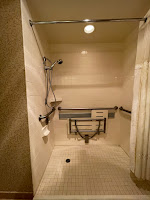 |
| St Lawrence River |
I grew up in the middle of the North American continent; yet one of my most indelible childhood memories is watching the ocean-liners from around the world sail under the St Louis Bridge. Thanks to the St Lawrence Seaway, Duluth, Minnesota became a sea port, with ocean-going cargo ships from ports as far away as Europe and Asia. These behemoths could enter the St Lawrence River from the Atlantic Ocean, and then traverse the waterways, canals, and locks of the Great Lakes. Even though the majority of these ships today seem to be "lakers" that remain on the fresh water of the Great Lakes, there are still some "salties," that sail the length of the St Lawrence and out the gulf to the ocean beyond. At any rate, after centuries of dreaming about it and decades of building it, the St Lawrence connects the middle of the continent to the rest of the world. So, it was with both anticipation and nostalgia that one the "points" of the road trip was to follow the St Lawrence River from its mouth, where it mixes with the Atlantic Ocean at the Gulf of St Lawrence, to its source in Kingston, Ontario, where it flow out of Lake Ontario.
 |
| Cap des Rosiers lighthouse and the mouth of the St Lawrence River |
.jpg) |
| St Lawrence River, N Gaspe Peninsula, Quebec |
This cape, where the river empties out into the Gulf of St Lawrence in the Atlantic Ocean, has been witness to numerous shipwrecks. Widening to 62 miles across near the mouth, we couldn't even see the other side, and this northeast section of the river felt more like an ocean.
 |
| Bike trail along St Lawrence River |
Quebec City and Montreal are indeed part of the St Lawrence River experience, but since there is so much in each, they each get a whole separate blog post.
 |
| Ile d'Orleans strawberries in Quebec City |
 |
| Boulangerie Pâtisserie Le Croquembouche in Quebec City |
For about 3 hours, we followed the St Lawrence River from Quebec City to Montreal, where the narrower river (still wide, for a river) seemed to be another road for transport.
 |
| Portneuf Harbor trail-- (unpaved section) |
About 60 km southwest of Quebec City, we stumbled upon the town and harbor of Portneuf, and we got out of the car to try the accessible harbor trail. The trail, partially paved and partially surfaced with hard-packed stone, loops around the harbor near an accessible restaurant and on the river.
The Portneuf harbor includes a boat ramp — a great way to wheel down to the river and test the temperature.
 |
| Fromagerie du Grondines |
Another serendipitous find was the cheese shop in Grondines. It looked inaccessible, but they invited us to roll up the ramp to the delivery entrance. We were rewarded with a cabinet full of cheese with flavors I'd never heard of before. Luckily, the guy behind the counter had recommendations, and I will forever dream of the ones I ended up buying and trying,
 |
| Ecological Park of Anse du Port |
Before reaching Montreal, we stopped at the Ecological Park of Anse du Port near Nicolet. The highlight of the park is a 3-mile accessible boardwalk loop through woods and over wetlands to a platform overlooking the spot where the River Nicolet flows into Lake St Pierre. There is also an accessible visitors center with an accessible restroom.
 |
| Ecological Park of Anse du Port |
 |
| Trail overlook: Lake St Pierre |
 |
| 2 of 1000 Islands |
From there, one could board boats offering tours of the 1000-Islands region, with its castles and vacation mansions. I think every rock was counted as an island in order to reach the lofty title of this historic vacation-land.
Along the way, we passed huge cargo ships headed to the Great Lakes from the Atlantic Ocean, plying their way through the river and locks,
 |
| Lake Ontario -- source of St Lawrence River |
After about 3 hours, we reached Kingston, ON and Lake Ontario — the source of the St Lawrence River. With our usual Mario Andretti driving to catch the sunset, we were able to use some of the paved trails along the edge of the lake to watch the setting sun.
The trip continues: Northern Ontario by Lake Ontario and Lake Huron






.jpg)



































